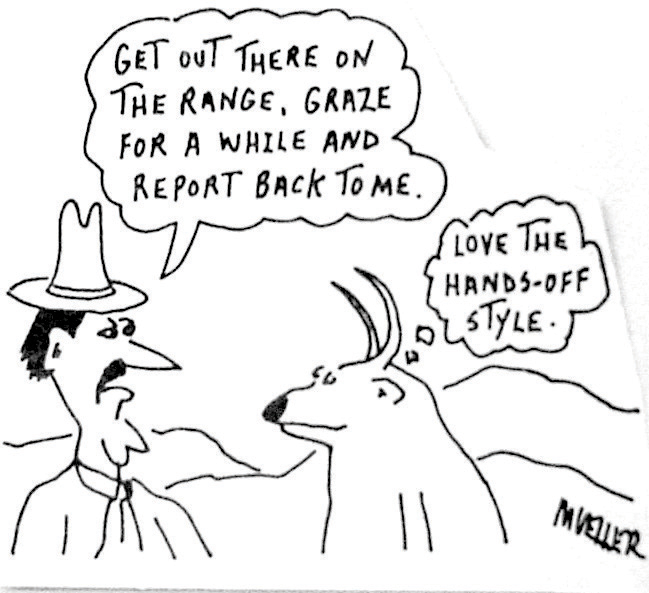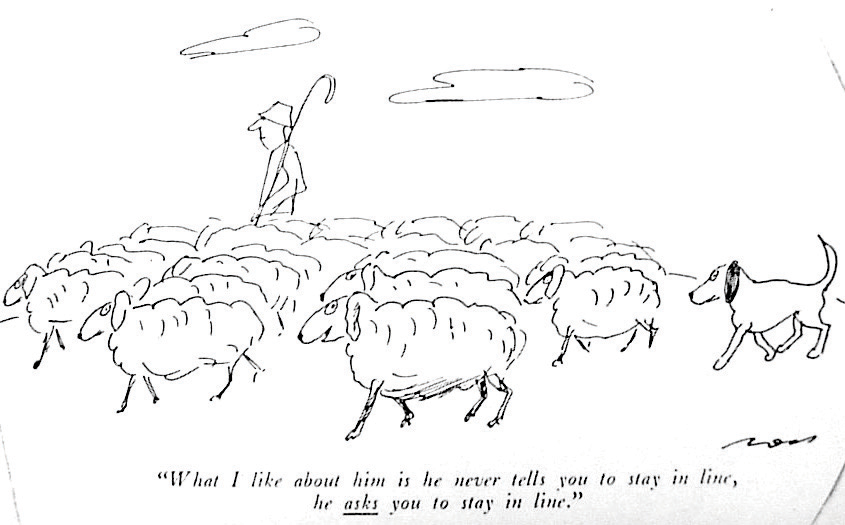This is “Diverse Forms of Leadership”, section 8.5 from the book An Introduction to Group Communication (v. 0.0). For details on it (including licensing), click here.
For more information on the source of this book, or why it is available for free, please see the project's home page. You can browse or download additional books there. To download a .zip file containing this book to use offline, simply click here.
8.5 Diverse Forms of Leadership
PLEASE NOTE: This book is currently in draft form; material is not final.
Learning Objectives
- Distinguish between laissez-faire, autocratic, and democratic leadership styles.
- Describe differences between transactional and transformational leadership.
- Identify examples and characteristics of matriarchal leadership.
- Identify differences between leadership styles associated with males and females.
President Harry Truman once said he didn’t want economists hedging by saying, “On the one hand” and then adding “but on the other hand.” Truman said: “Bring me a one-armed economist.”Godden, J. (2008, April 28). Send for a one-armed economist. Seattle Post Intelligencer. Retrieved from http://www.seattlepi.com/local/opinion/article/Send-for-a-one-armed-economist-1271762.php
Jean Godden
Leadership theory resembles economics in at least one respect. Despite the fact that leadership has been investigated intensively for decades, if not centuries, no one has come up with a definitive prescription for how to practice it in every situation. The major reasons for this failure are that every situation differs from every other situation, and every leader differs from every other leader. What is great leadership, then? It depends!
Gay and Donald LumsdenLumsden, G., & Lumsden, D. (2004). Communicating in groups and teams: Sharing leadership (4th ed.). Belmont, CA: Wadsworth/Thompson Learning. described this situation succinctly: “This is one of those good-sense things. You can’t expect one approach to work in all situations.” Diverse people with diverse personalities in diverse situations call for diverse forms of leadership.
A “Goldilocks” Continuum of Leadership
Although it was perhaps simplistic even when it were proposed half a century ago, a continuum of three styles of leadership may seem at first glance to be logical. It’s soothing, isn’t it, to think that, like Goldilocks, we can consider and rule out possibilities that are “too this” and “too that” in favor of a choice that’s just right?

At one end of a leadership continuum proposed in the 1960s and 1970sWhite, R.K., & Lippett, R.O. (1960). Autocracy and democracy. New York: Harper & Row., Likert, R. (1967). The human organization: Its management and value. New York: McGraw-Hill. lies laissez-faire leadershipA “live and let live” style of leadership; a willingness to let people in a group behave as they wish., whose main feature is a willingness to let people in a group behave as they wish. If a group comprises skilled and competent members who willingly share responsibilities and are already motivated to work hard, this kind of leadership may be appropriate—or, at least, it may not cause harm to the group. Most individuals and groups, however, are apt to have difficulty maintaining focus and productivity under laissez-faire leadership.
At the other end of the continuum would be autocratic leadershipA style of leadership in which group members are strictly controlled, monitored, and commanded by the leader., also known as command and control management.Zak, M.W. (1994). “It’s like a prison in there”: Organizational fragmentation in a demographically diversified workplace. Journal of Business and Technical Communication, 8, 281–298. An autocratic leader uses coercive power or the dispensation or withholding of rewards to control how the group operates. Some group members may appreciate, or at least accept, autocratic leadership because of the structure and definitiveness it provides. In fact, when autocratic leadership is first imposed on a group, it can increase short-term productivity.Lumsden, G., & Lumsden, D. (2004). Communicating in groups and teams: Sharing leadership (4th ed.). Belmont, CA: Wadsworth/Thompson Learning. Later, however, aggressive behavior may develop under an autocratic leader, and turnover rates are likely to rise.


In the middle of the continuum, in the place that Goldilocks would presumably have considered to be just right, is democratic leadershipA style of leadership in which the leader distributes responsibility and shares power with group members.. Sometimes called “participative leadership,” this variety is characterized by distribution of responsibility among group members; empowerment of the members to determine their activities and express their opinions freely; and assistance with (but not domination of) the group’s decision-making. Under this kind of leadership, most or all of a group’s members are entrusted to perform important functions and may actually sometimes exchange the roles of leader and follower.Gastil, J. (1994). A definition and illustration of democratic leadership. Human Relations, 47, 953–975. Native-born Americans might consider democratic leadership to be the ideal kind, but it yields benefits in some situations more than in others. It is most advantageous when a group is first forming, and other factors that contribute to its success are breadth of talent and ideas among group members and lack of clarity about the group’s goals.
Transactional and Transformational Leadership
A new movement in leadership theory, known at the time as “new leadership,” first emerged in the 1980s and 1990s. Among other things, its adherents drew a distinction between transactional leadershipA behaviorist approach to motivating group members in which leaders exchange rewards for performance. and transformational leadership. BrymanBryman, A. (1992). Charisma and leadership in organizations. London: Sage. wrote that transactional leaders exchange rewards for performance. In other words, they employ what we will describe in our next chapter as a behaviorist approach to motivating group members.
Transformational leaders, by contrast, provide group members with a vision to which they can all aspire. They also work to develop a team spirit so that it becomes possible to achieve that vision.
Den Hartog, Van Muijen, & KopmanDen Hartog, D.N., Van Muijen, J.J., & Kopman, P.L. (1997). Transactional versus transformational leadership: An analysis of the MLQ (Multifactor Leadership Questionnaire). Journal of Occupational and Organizational Psychology, 70, 19–35. distinguished clearly between these two kinds of leaders. They held that transactional leaders motivate group members to perform as expected, whereas transformational leaders inspire followers to achieve more than what is expected. NanusNanus, D. (1992). Visionary leadership: Creating a compelling sense of direction for your organization. San Francisco: Jossey-Bass. wrote that transformational leaders accomplish these tasks by instilling pride and generating respect and trust; by communicating high expectations and expressing important goals in straightforward language; by promoting rational, careful problem-solving; and by devoting personal attention to group members.
Matriarchal Leadership
We’ve discussed in other parts of this book how gender can affect interactions in small groups. We haven’t touched yet, however, on the implications of matriarchal leadershipLeadership in which women exercise primary influence instead of men on how whole societies and the groups within them function.—leadership in which women exercise primary influence instead of men—on how whole societies and the groups within them function. Examples of such leadership from North America, Africa, and Europe will help us understand some of those implications.
In Native American society, women have long occupied major leadership roles. Anthony DayDay, A. (2004, Jan 16). Book review: The worlds of Pocahontas; Pocahontas: Medicine woman, spy, entrepreneur, diplomat; Paula Gunn Allen; Harper San Francisco. Los Angeles Times, pp. 27–E.27. Retrieved from http://search.proquest.com/docview/421887463?accountid=1611 noted that a book by Paula Gunn Allen made this point with reference to three Native American women known today for the guidance and support they provided to men exploring North America: Pocahontas, who saved John Smith in early Virginia and later wed Captain John Rolfe; Malinche, Hernán Cortés’s lover and the mother of his son; and Sacagawea, without whose help the Lewis and Clark expedition might have ended in disaster. According to Allen, each of these women was “doing the traditional work of highborn Native American women in a matriarchal society.” Furthermore, each occupied a leadership position among her own people which made it possible for her to enact change, bridge worlds, and bring about harmony among diverse groups.
Two other authoritiesTarrell Awe, A. P., & Michael, T. G. (2005). Beloved women: Nurturing the sacred fire of leadership from an American Indian perspective. Journal of Counseling and Development : JCD, 83(3), 284–291. Retrieved from http://search.proquest.com/docview/219017519?accountid=1611 have had this to say about leadership in today’s Native American tribal groups: “American Indian governance is filled not with the romantic notion of male ‘chiefs’ … but with tribal councils or committees consisting of multiple leaders (male and female) holding positions of leadership, most often with a group of women holding the ultimate power for decisions that affect the entire tribe.” These same writers also quoted a Mohawk Woman, Lorraine Canoe, As cited in McFadden, S. (Ed.). (1994). The little book of Native American wisdom. Rockport, MA: Element. as saying, “We are a matriarchal society. Even our language honors the women. It is a female language. When we dance, the men dance on the outside of the circle. The inside of the circle is to honor the women.”
Ellen Sirleaf-Johnson, who in 2005 became the first elected female head of state in Africa and was awarded the 2011 Nobel Peace Prize with two other Third World women, noted that “at least 250 prominent African women leaders have made the ‘history books’ since Western historians took an interest in Africa, let alone those that passed unrecorded but live on in folk history.”Johnson-Sirleaf, E. (2010) Africa’s women have led in the past, and will lead in the future. New African, 78–79. Retrieved from http://search.proquest.com/docview/807485982?accountid=1611. According to Sirleaf-Johnson, these leaders have included chiefs, queens, ministers, prime ministers, and others. Liberia, where Sirleaf-Johnson is president, has six female cabinet ministers who hold strategic positions, including justice, foreign affairs, agriculture, and commerce.
In contemporary Europe, women occupy far fewer upper-level leadership positions in business than do men, but their numbers are greater in family-run corporations than in listed companies. According to Richard Milne,Milne, R. (2008, October 15). A matriarchal leadership. FT.Com. Retrieved from http://search.proquest.com/docview/229232082?accountid=1611. women in European family-held businesses tend to be guided by four distinctive drives: a focus on long-term rather than short-term goals; a sense of empathy for co-workers, including subordinates; a desire to emulate their own mothers’ style of organizing a family; and a powerful commitment to support the business in times of challenge.
Asia covers a vast area encompassing many diverse cultures and sociological features. It is also a fast-changing region of the world, technologically, economically, and culturally. Recent writings indicate, however, that matriarchal leadership has existed there for centuries in at least parts of China and is established also as part of Philippine culture.
Among the approximately 50,000 members of the Mosuo ethnic group in remote southern China, until as recently as 15 years ago the women made all major decisions and held the purse strings. Property and names still pass from mothers to daughters in the area’s agrarian villages. One man interviewed by the author of an article about the areaFarley, M. (1998, Dec 26). Saturday journal; In Lugu Lake, marriage is a ticklish affair; females call the shots as men hand over matters of life and love in remote Chinese matriarchal society. Los Angeles Times, pp. 1–1. Retrieved from http://search.proquest.com/docview/421475684?accountid=1611 said that in his small business transactions with outside visitors “I hand the money over to my wife’s mother. She gives me enough to buy cigarettes and a drink, and I do what she says.” The headman of another village informed the author that he made decisions outside the village but not inside. “If I want to do something,” he said, “I must get permission from my mother.”
A study of women in positions of business leadership in the Philippines revealed several features related to matriarchy.Roffey, B. (2002). Beyond culture-centric and gendered models of management: Perspectives on Filipina business leadership. Women in Management Review, 17(7), 352–363. Retrieved from http://search.proquest.com/docview/213138203?accountid=1611. First, the businesses examined in the study displayed greater interconnectedness with the women’s families than is usually the case in Western male-led firms. Employees were in many instances treated as family members, even to the extent of being provided with food and accommodation. Second, the values which the women associated with effective leadership included several that are generally linked to women’s perceived strengths: diplomacy, tact, “grace,” “charm”, “humility,” and “integrity.”
Male vs. Female Leadership
The “nature versus nurtureThe question of how much of human behavior is caused by biological factors and how much of it results from features of the environment.” debate continues to rage in the social sciences. Controversy still exists over how much of human behavior is caused by biology and how much of it results from social conditioning. The American political scientist Francis Fukuyama,Fukuyama, F. (1998). Women and the evolution of world politics. Foreign Affairs, 77(5), 24–40. Retrieved from http://search.proquest.com/docview/214292115?accountid=1611. however, has forcefully contended that “virtually all reputable evolutionary biologists today think there are profound differences between the sexes that are genetically rather than culturally rooted, and that these differences extend beyond the body into the realm of the mind.”
What might some of these differences be when it comes to leadership, and how persistent might they be? Fukuyama answered that “male tendencies to band together for competitive purposes, seek to dominate status hierarchies, and act out aggressive fantasies toward one another can be rechanneled but never eliminated.” According to him, boys have been shown in hundreds of studies to be more aggressive, both verbally and physically, in their dreams, words, and actions than girls.
With respect to international relations, Fukuyama wrote that women are less likely than men to see force as a legitimate tool for resolving conflicts. Ellen Sirleaf-Johnson added that “it is the skills of cooperation and collaboration that count in a new age of interconnectedness, qualities in which women excel.”Johnson-Sirleaf, E. (2010, Africa’s women have led in the past, and will lead in the future. New African, 78–79. Retrieved from http://search.proquest.com/docview/807485982?accountid=1611 And in the Philippine businesses studied by Roffey, the women leaders were more frequently found to demonstrate nurturance and flexible risk-taking than traits often ascribed to male leaders, such as firmness and single-mindedness.
Key Takeaway
Leadership can take many forms, including nontraditional ones such as matriarchal leadership, and the results of various forms may differ substantially.
Exercises
- Think of the last several movies you’ve watched. Who took leadership in their stories, and how effectively? Assuming that the leadership was not matriarchal, how do you think the films would have come across differently if the leadership had featured women rather than men? How do you think men and women in the audience might have reacted differently?
- If all their skills and authority were the same, and you were forced to choose between a woman and a man as the leader of a group you were part of, what choice would you make? Would it depend on what kind of group? If so, why? Explain your answers to a classmate.
- Google “women heads of state” and determine how many countries in the world are currently led by women. Would you expect any common threads among the countries, or among their leaders? Why or why not?





